So often the cultural aspects of a place can get lost in the shuffle of modernization. I've got a treasure to share with you today - a new book, written by our Astounding Himalayas Editor, Sumit Vashisht. Sumit has shared so much of the Himalayas with us - from architecture to trekking to ice skating. It's a window into another world, for me - a world I can't wait to explore. Sumit's book, Shimla - A British Himalayan Town, is an extraordinary glimpse into the town of Shimla, India - in the Himalayas. It's a place that is an amalgamation of styles, cultures, architecture...and one that Sumit explores in this book.
Church
We were lucky enough to sit down and talk with Sumit about his book, Shimla, architecture, history, culture, and more. Here's what he had to say...
YMCA
WE: Please tell us about your book, Shimla - A British Himalayan Town...
SV: This is the story of origin and settlement of the growth of a small village called Shyamala to Shimla. It changed many names such as Shumla, Semlah, Simla and now Shimla. There used to be a small village with 10 - 15 houses at this place and theall and the Northern Hills suffered a lot of disturbance from Gurkha attacks from Nepal. The books tells you the story of defeat of Gurkhas by the British Army in 1815 as the local dynasties asked them for help. The British liked the place so much that they decided to settle down some army posts here, them it became a famous holiday resort and in 1860 it was strongly recommended by Sir John Lawrence, the then Viceroy, to be used as Summer Capital of the British Government in India. The book gives you the details of the settlement of the town.
Windows at the Mall
Band Stand - Gofa Restaurant
WE: What inspired you to write this book?
SV: My love for this lovely town. Its own beauty, its architecture, its fascinating buildings, lanes, streets, roads, flora & fauna, people and after my birth and initial 14 years of my life in this town my separation from it, my childhood memories.
Shimla
Elisyum Hill
WE: Please tell us a bit about Shimla town...
SV: The Goddess Kali is widely worshipped in these hills perhaps because the area was ruled by the Sen Dynasty who initially came from Bengal. Sens are the Royal family of Junga, a small town twenty six kilometers from Shimla. One of their ancestors, Raja Balbir Sen of Bengal is said to have settled down in Allahabad in 1210 AD. He faced several problems caused by the Muslims. His son, Rup Sen, came to Ropar, located near Chandigarh in Punjab. There he built a fort for himself and once again Muslim aggressors forced his three sons to flee in three different directions. Hamir Sen escaped to Kishtwar near Jammu in Jammu & Kashmir, Bir Sen rushed to Suket where he set up his dynasty. At present that place is known by the name of Sundernagar. The third son, Giri Sen, came to Shimla hills and established Keonthal Estate. Later it was shifted to Junga in 1211 AD. Everything went well till the Gurkhas invaded the Shimla hills in 18th century. The area suffered a lot due to Gurkhas as they were cruel to the people of North Indian hills.
Towards the end of the 18th and the beginning of the 19th century, the hill states experienced several Gurkha invasions. Local dynasties did not have the power to protect their kingdoms from the Gurkhas and they asked the King of Punjab to help them. Finally a battle was fought in 1804 between the Sikhs and the Gurkhas in Kangra in which the Gurkhas suffered complete defeat.
Thousands of their men lost their lives in battle and some died due to disease. But the Gurkhas continued to attack smaller hill states in the region. Udhap Singh wrote in his book ‘Gurkha Conquest of Arki’ ‘They ate so many goats that the price of the useful animal rose to Rupees thirty per head at that time’. The Gurkhas built various fortresses around Shimla. They were at
Bilaspur, Solan, Sirmour and Shimla. Presently, most of them are in ruins and suffer neglect. One of them was built at Malaon named as Malaon Castle near Nalagarh in Solan District. Second was at Banasar twenty two kilometers from Kumarhatti on the Kalka-Shimla Highway. Another was at Subathu called Subathu Gurkha Fort, 70 kilometers from Malaon. This fort is still being used by the Indian army and is under the 14 Gurkha Training Centre. A 190 years old cannon of Malaon Castle is kept there. The other one is at Nauni on the Solan - Rajgarh road. The fort is in ruins, but the approach to the fort is amazing. Jagatgarh was also one of the strongholds of the Gurkhas. Later this was known as Jutogh. Even now it is with the Indian Army and houses the cantonment.
It was in 1815 that the British intervened and Major General David Ochterlony was sent to help locals. During the wars with the British army the Gurkhas lost one of their prominent leaders, Bhakti Thapa. Some of them refused to continue. Their opposition ended when Umar Singh, another prominent leader, surrendered. After that many of them came and joined the British Army and served it with loyalty and devotion. Even now the British Army continues to have a separate regiment for Gurkhas called The Gurkha Regiment. Shimla came in notice of the world outside in early ninteenth century when three British Brothers, called Gerard Brothers, were on there way to survey the Satluj Valley. It is mentioned in Captain Gerard's book, 'Travels to Kunnoowar' that they came across a small village called Shyamala while heading towards North.
Barne's Court - New Governor's House
Viceregal Lodge
WE: How did the British occupation of Shimla change the town?
SV: Shimla remained a summer retreat, a holiday resort and a summer capital for the British Government from 1822 to 1947. They brought here everything. They built here everything. They prepared here everything that was neccessarily required to lead a smooth life. Although here in the hills life is very simple, but the British made it stylish, and the present generation still follows the British lifestyle.
The British constructed roads to Shimla and also got is connected to the plains through railways. They introduced the best schools of India for both the genders, brought Medical facilities for locales and European population of the town, gave us the club culture and those clubs are still in use. Every summer to control the entire subcontinent form here, they built the Viceregal Lodge. Now, this building, still the most beautiful in the North India is being used as an Institute of Advanced Study. A visit to Shimla is a failure if this building is missed. This, marvel example of Baronial- Scottish architecture stands on the Observatory Hill at the western end of Shimla.
Gunj Bazaar
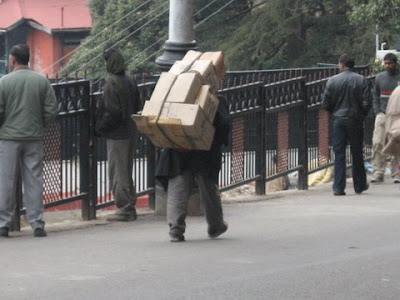
A porter in Shimla
WE: You've got letters in your book, from people residing in Shimla, to family back home in the UK...how did you find and access these? What do they tell of the history of Shimla?
SV: They had come to Shimla as tourists and it was by chance that I was their guide. During the discussion I mentioned that I was writing a book on Shimla. So the lady Mrs. Engleheart, told me that her grandfather Mr. Semual Wilberforce worked here in Shimla as a Judge and every week he would write to his mother in UK. She told me that all those letters were published in a form of a book by her uncle and promised to send me a copy of those letters.
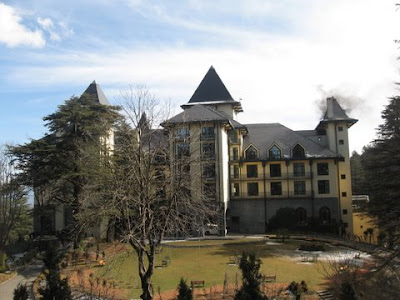
Wildflower Hall

WE: Can you please share with us some of the British architecture in Shimla? How is that different from native architecture?
SV: Shimla has, the most famous, Mock Tudor Structures which can be seen all over the town, Neo Gothic Gaiety, Swiss Bavarian, Norman Baronial, Scottish, and of course Hill architecture. The style of architecture, a blend of Himalayan and Mock Tudor styles, used in many old houses in Shimla, was adopted by early builders. Even today, if one goes to upper Himalayan regions such as the Pabbar Valley, Baspa Valley or Tirthan Valley, similar old wood frame houses can be found and even today are being built.
Interestingly no binder such as cement was used. Later came mud plaster mixed with cow dung and grass which provided strength to walls.
But in most of Shimla, buildings one can find Stones used for the wallls and slates or tin sheets to cover the rooftop.
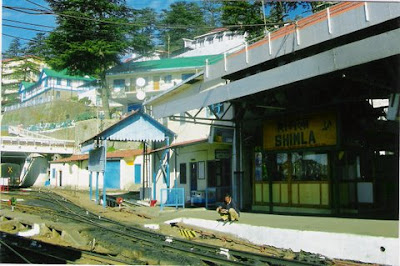
Shimla Railway Station
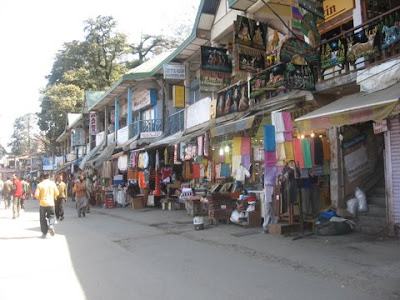
Lakkar Bazaar
WE:Is there anything else you'd like to share with us?
SV: Shimla is losing its beauty as there is no provision to protect the old buildings. These old houses are the real taste of Shimla and once we have lost them all, we shall be living in a modern Metropolitan in the lap of Himalayas.
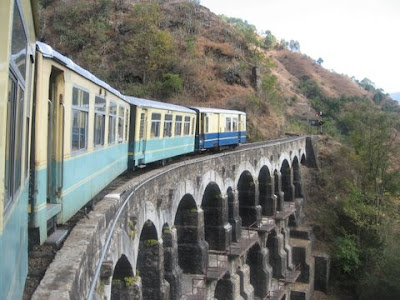
Kanoh Bridge
WE: Thanks so very much, Sumit - this book is a treasure!
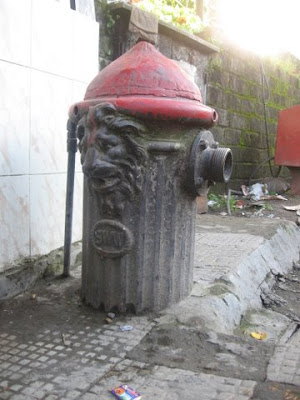
Fire hydrant
All photos courtesy and copyright Sumit Vashisht.
